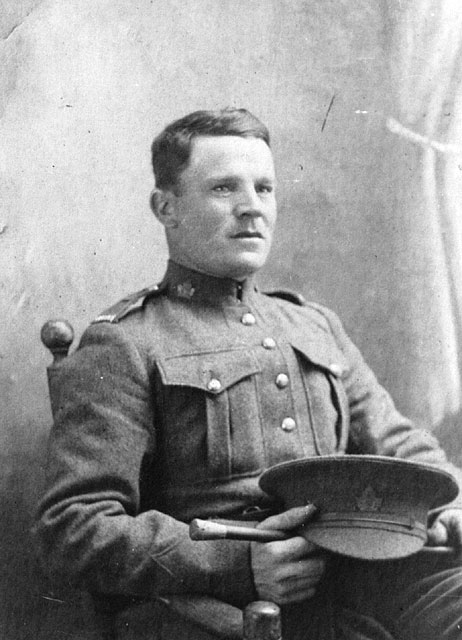By Andrew Horrall
When Claude Joseph Patrick Nunney joined the 38th Battalion on March 8, 1915, he stated that he was born in Dublin, Ireland, on December 24, 1892. This appears not to have been strictly true, though it is unclear why Nunney obscured his origins. Archival records point to Nunney having been born on that day in Hastings, England, and given the name Stephen Sargent Claude Nunney. It is certain that he was orphaned as a child and sent across the Atlantic to Ottawa, where he was adopted at first by Mrs. D. J. MacDonald, of North Lancaster, Ontario. By the time he enlisted, he was living with the Calder family of Glengarry County, Ontario, whom he identified as his next of kin and to whom he remitted money each month.
Nunney was an outstanding soldier who was awarded the Distinguished Conduct Medal for his actions at the Battle of Vimy Ridge in April 1917, when “although wounded in two places and his section wiped out he continued to advance carrying his gun and ammunition and alone stopped an attack by over 200 enemy. He continued on duty for three days showing exceptional fearlessness and doing magnificent work.” (London Gazette, no. 30234, 16 August 1917) Soon afterwards, he was awarded the Military Medal for another act of bravery.

Private Claude Nunney, VC, of the 38th Battalion (a006859)
Nunney’s promotion to sergeant in June 1917 testified to his battlefield leadership and courage. But the following April, he was court-martialed for striking a superior officer. The incident is detailed in the records of Nunney’s court-martial, which are held by LAC. The facts of the case were clear, though two officers testified in Nunney’s defence, with one calling him “one of the best front line fighting men in the Battalion.” Nunney was convicted and demoted back to private, though his sentence of one year’s hard labour was soon commuted “on account of [Nunney’s] previous good service.”
Private Nunney was awarded the Victoria Cross posthumously for his actions on September 1 and 2, 1918, during the fighting at the Drocourt-Quéant Line in France. During a German attack “Nunney, who was at this time at company headquarters, immediately on his own initiative proceeded through the barrage to the company outpost lines, going from post to post and encouraging the men by his own fearless example. The enemy were repulsed and a critical situation was saved. During the attack on 2nd September his dash continually placed him in advance of his companions, and his fearless example undoubtedly helped greatly to carry the company forward to its objectives.” (London Gazette, no. 31067, December 14, 1918)
Nunney was severely wounded while carrying out these courageous acts and died on September 18, 1918. He left all his effects, including his medals, to the Calders. When Canadian Victoria Cross recipients assembled at Toronto in 1938, the widowed Mrs. Calder was too old to attend. So she asked a female friend in Alexandria, who was an advocate for veterans’ welfare, to wear Nunney’s medals at the gathering. The orphaned Irish boy had been adopted by an entire community. His Victoria Cross is held by the Cornwall Armoury. Library and Archives Canada holds his service file.
Sources
“Spirit of war hero marches on in VC,” The Globe and Mail, August 2, 1938, p. 5.
Andrew Horrall is a senior archivist in the Private Archives Division at Library and Archives Canada.

Dear Mr Horrall, There appear to be a large number of inaccuracies in your post. He was born in Hastings, but in July 1892. He was not an orphan. He was a Home Child. He was not adopted by Mrs MacDonald. She died during the war, and he nominated a friend to be the beneficiary, Mr G Calder. in 1938, Mr G Calder was alive. Yes Claude Nunney was represented by a long term friend.
Yours faithfully Peter Silk